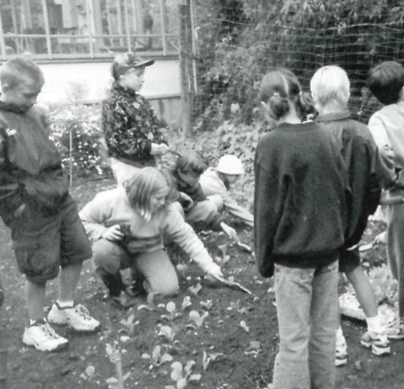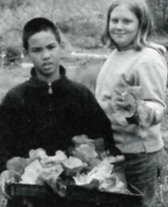
The garden, wrote British author Thomas Hill in 1577, is a “ground plot for the mind.” Granted, “but also for the heart,” I reckon early this morning, down on my hands and knees, weeding the sinuous paths of our newest, four-month-old kids’ garden.
Gardens are not created or made, they unfold, spiraling open like the silk petals of an evening primrose flower to reveal the ground plot of the mind and heart of the gardener and the good earth. At least this is the way the kids’ garden evolved when, early last March, my 23-year-old dharma buddy, Suehiko Ono, and I stood on the ragged, 40-foot-by-40-foot spit of weedy wasteland where we have been scrubbing and storing our compost buckets for a few years and watched as a new garden emerged, hissing and wild-eyed, from out of our minds.
For over 20 years Green Gulch Farm has welcomed local schoolchildren and their teachers to come work with us on the farm. Running herd over the Gulch, these children taste the fruit of wall-gazing Zen, sometimes sweet as a Black Tartarian cherry ripening at midsummer, sometimes tart as a lime-green gooseberry plucked and ejected on the run. We imagined a new garden, small and fat with food planted, grown, and harvested by kids, a secret garden well hidden behind an eight-foot high semi-permeable membrane of giant sunflowers woven into the dome of the pale blue sky. We had a missionary motive, thinly disguised: that as this garden unfolded, teachers and students would be inspired to start their own edible schoolyard plots.

We set to work immediately, composing the garden with scrounged materials and raw nerve. First we just sat on the mangy rump of the land, listening to the hum of the ground. I heard a great wheel turning deep in the earth, its sprockets engaging with the ground plot of the mind, until our garden unfolded in a wheel pattern with eight-spoke beds revolving around the central hub and planted in honor of the Eight-Fold Path, the road to enlightened living mapped out by the Buddha.
At the edge of the garden was an abandoned clutch of rusty iron bathtubs. With kids we painted the tubs in the colors of the four directions and set them out—north, east, west and south (the acronym NEWS comes from these same compass points) and filled the tubs with shredded paper and rotten food scraps and began to raise writhing tangles of worms, the “intestines of the earth,” as Darwin observed 150 years ago.
Schoolchildren from Hayes Valley to Hunters Point planted the eightfold beds with Suehiko. They quickly shortened his name to “Mr. Yo” and energetically set out the sunflowers and speckled bean seed gathered from war-torn Balkan gardens. The beds were planted with Easter egg radishes, butter lettuce, Yaqui blue corn, stone-age wheat, sacred quinoa and amaranth, red, white and blue potatoes to be harvested on July fourth, and squash from Guatemala, Japan, France and New England. In the center hub of the eightfold garden older kids dedicated a Sierra Beauty apple tree underplanted with circles of sequoia strawberries.
Now summer rules the garden and the turning wheel groans with ripening crops. The Kosovo beans twine up their sagging trellis, standing at seven feet and still growing, while the first crop of lettuce is long gone, harvested by kids for the Dalai Lama on his recent Bay Area teaching visit. Grounded by the sobering loss of more than 300,000 small farms that have folded in the last twenty years, we replant our eightfold garden for the weal of the world.